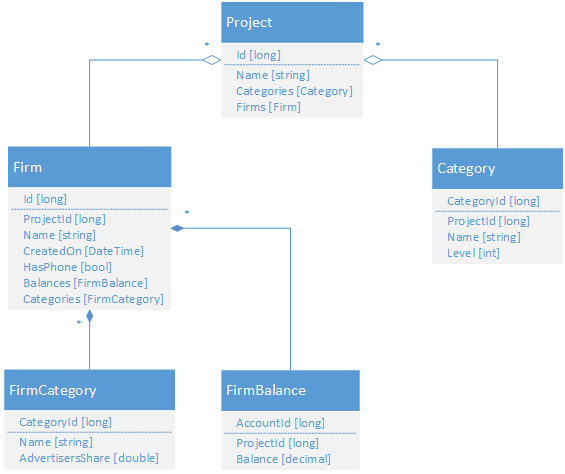Getting Started
High-level design overview
Third-party libraries
High-level design overview
NuClear River platform consists of two components: Querying and Replication. Technically, they are independent from each other. But metadata descriptions used for both to describe a specific bounded context should be coordinated.
Let's take a look at Querying first. It's a very simple application that exposed API throught HTTP in terms of OData protocol. This application built on ASP.NET Web API and uses Microsoft.AspNet.OData and EntityFramework libraries.
So, OData protocol usage gives us two main profits:
- OData metadata, a machine-readable description of the data model of the APIs
- An opportunity to client to construct an arbitrary query based on OData metadata
OData service uses an abstract data model called Entity Data Model (EDM) to describe the exposed data in the service. To construct EDM model Querying component uses metadata descriptions. Moreover, concept of bounded contexts is fully supported, so you can have as many EDM models as you need. From OData side, bounded contexts are implemented with Entity containers.
It's important that metadata descriptions describe not only EDM model, but the API of Querying too. Hense, you just need to create metadata for your bounded context and Querying component in will start to use it to execute queries for Read Model.
Here is the example. Say, bounded context looks like this:

Here we have one aggregate - Project. It has two entities except aggregate root - Category and Firm, and two value objects - FirmBalance and FirmCategory that related to Firm entity.
So, let's describe it with metadata descriptions:
StructuralModelElementBuilder ConceptualModel =
StructuralModelElement.Config
.Elements(
EntityElement.Config.Name(EntityName.Project).EntitySetName("Projects")
.HasKey("Id")
.Property(EntityPropertyElement.Config.Name("Id").OfType(ElementaryTypeKind.Int64))
.Property(EntityPropertyElement.Config.Name("Name").OfType(ElementaryTypeKind.String))
.Relation(EntityRelationElement.Config.Name("Categories").DirectTo(EntityElement.Config.Name(EntityName.Category)).AsMany().AsContainment())
.Relation(EntityRelationElement.Config.Name("Firms").DirectTo(EntityElement.Config.Name(EntityName.Firm)).AsMany().AsContainment()),
EntityElement.Config
.Name(EntityName.Category).EntitySetName("Categories")
.HasKey("CategoryId")
.Property(EntityPropertyElement.Config.Name("CategoryId").OfType(ElementaryTypeKind.Int64))
.Property(EntityPropertyElement.Config.Name("ProjectId").OfType(ElementaryTypeKind.Int64))
.Property(EntityPropertyElement.Config.Name("Name").OfType(ElementaryTypeKind.String))
.Property(EntityPropertyElement.Config.Name("Level").OfType(ElementaryTypeKind.Int32)),
EntityElement.Config
.Name(EntityName.Firm).EntitySetName("Firms")
.HasKey("Id")
.Property(EntityPropertyElement.Config.Name("Id").OfType(ElementaryTypeKind.Int64))
.Property(EntityPropertyElement.Config.Name("ProjectId").OfType(ElementaryTypeKind.Int64))
.Property(EntityPropertyElement.Config.Name("Name").OfType(ElementaryTypeKind.String))
.Property(EntityPropertyElement.Config.Name("CreatedOn").OfType(ElementaryTypeKind.DateTimeOffset))
.Property(EntityPropertyElement.Config.Name("HasPhone").OfType(ElementaryTypeKind.Boolean))
.Relation(EntityRelationElement.Config.Name("Balances")
.DirectTo(
EntityElement.Config
.Name(EntityName.FirmBalance)
.HasKey("AccountId")
.Property(EntityPropertyElement.Config.Name("AccountId").OfType(ElementaryTypeKind.Int64))
.Property(EntityPropertyElement.Config.Name("ProjectId").OfType(ElementaryTypeKind.Int64))
.Property(EntityPropertyElement.Config.Name("Balance").OfType(ElementaryTypeKind.Decimal))
).AsMany())
.Relation(EntityRelationElement.Config.Name("Categories")
.DirectTo(
EntityElement.Config
.Name(EntityName.FirmCategory)
.HasKey("CategoryId")
.Property(EntityPropertyElement.Config.Name("CategoryId").OfType(ElementaryTypeKind.Int64))
.Property(EntityPropertyElement.Config.Name("Name").OfType(ElementaryTypeKind.String))
.Property(EntityPropertyElement.Config.Name("AdvertisersShare").OfType(ElementaryTypeKind.Double))
).AsMany().AsContainment()));
Having this description of bounded context, Querying produces the following OData metadata:
<?xml version="1.0" encoding="utf-8"?>
<edmx:Edmx Version="4.0" xmlns:edmx="http://docs.oasis-open.org/odata/ns/edmx">
<edmx:DataServices>
<Schema Namespace="Querying.CustomerIntelligence" xmlns="http://docs.oasis-open.org/odata/ns/edm">
<EntityType Name="Project">
<Key>
<PropertyRef Name="Id" />
</Key>
<Property Name="Id" Type="Edm.Int64" Nullable="false" />
<Property Name="Name" Type="Edm.String" Nullable="false" />
<NavigationProperty Name="Categories" Type="Collection(Querying.CustomerIntelligence.Category)" ContainsTarget="true" />
<NavigationProperty Name="Firms" Type="Collection(Querying.CustomerIntelligence.Firm)" ContainsTarget="true" />
</EntityType>
<EntityType Name="Category">
<Key>
<PropertyRef Name="CategoryId" />
</Key>
<Property Name="CategoryId" Type="Edm.Int64" Nullable="false" />
<Property Name="ProjectId" Type="Edm.Int64" Nullable="false" />
<Property Name="Name" Type="Edm.String" Nullable="false" />
<Property Name="Level" Type="Edm.Int32" Nullable="false" />
</EntityType>
<EntityType Name="FirmBalance">
<Key>
<PropertyRef Name="AccountId" />
</Key>
<Property Name="AccountId" Type="Edm.Int64" Nullable="false" />
<Property Name="ProjectId" Type="Edm.Int64" Nullable="false" />
<Property Name="Balance" Type="Edm.Decimal" Nullable="false" />
</EntityType>
<EntityType Name="FirmCategory">
<Key>
<PropertyRef Name="CategoryId" />
</Key>
<Property Name="CategoryId" Type="Edm.Int64" Nullable="false" />
<Property Name="Name" Type="Edm.String" Nullable="false" />
<Property Name="AdvertisersShare" Type="Edm.Double" Nullable="false" />
</EntityType>
<EntityType Name="Firm">
<Key>
<PropertyRef Name="Id" />
</Key>
<Property Name="Id" Type="Edm.Int64" Nullable="false" />
<Property Name="ProjectId" Type="Edm.Int64" Nullable="false" />
<Property Name="Name" Type="Edm.String" Nullable="false" />
<Property Name="CreatedOn" Type="Edm.DateTimeOffset" Nullable="false" />
<Property Name="HasPhone" Type="Edm.Boolean" Nullable="false" />
<NavigationProperty Name="Balances" Type="Collection(Querying.CustomerIntelligence.FirmBalance)" />
<NavigationProperty Name="Categories" Type="Collection(Querying.CustomerIntelligence.FirmCategory)" ContainsTarget="true" />
</EntityType>
<EntityContainer Name="DefaultContainer">
<EntitySet Name="Projects" EntityType="Querying.CustomerIntelligence.Project" />
<EntitySet Name="Categories" EntityType="Querying.CustomerIntelligence.Category" />
<EntitySet Name="Firms" EntityType="Querying.CustomerIntelligence.Firm" />
</EntityContainer>
</Schema>
</edmx:DataServices>
</edmx:Edmx>
Next, a client application can use this OData metadata to build bounded context's model on the client side (for example, with ODataJS library, or many others) to compose REST queries using OData syntax.
So, these description is the main part of Querying's configuration to customize its behaivour for your bounded context. There is some more detais about DI and mappings and configuration of data storage, you can find them in Querying design article.
Now, let's take a look at Replication component. It's a bit more complicated.
First of all, it's important to know that it's control flow consists at least of two parts/stages - primary and final. These terms also come from the NuClear.Operations* libraries used for extenal events processing.
There are main things we need to understand at this point:
- The primary stage used for extenal events receiving and processing. The main goal here is to sync facts storage with storage of the source system and generate commands to be processed on the next stage
- The final stage is responsible for receiving and processing of commands comes from the primary stage to construct aggregates using facts storage
In fact, these stages can be perceived as ETL-pipeline. We extract data at primary stage and then transform and load data at final stage.
So, as far as primary stage needed for data extraction, we can plug many source systems to NuClear River to compose data of bounded context from many sources.
Similar technique used at final stage. We can design aggregates in a way they consist of mandatory and optional objects. Mandatory objects is the set of entities and value object that define the meaning of the aggregate. Optional objects are value objects that supplement aggregate. So, we can have many final stages for the same aggregate - one to deal with mandatory objects and others (main flow) - to optional objects (additional flows).
To get more details on Replication see Replication design article.
